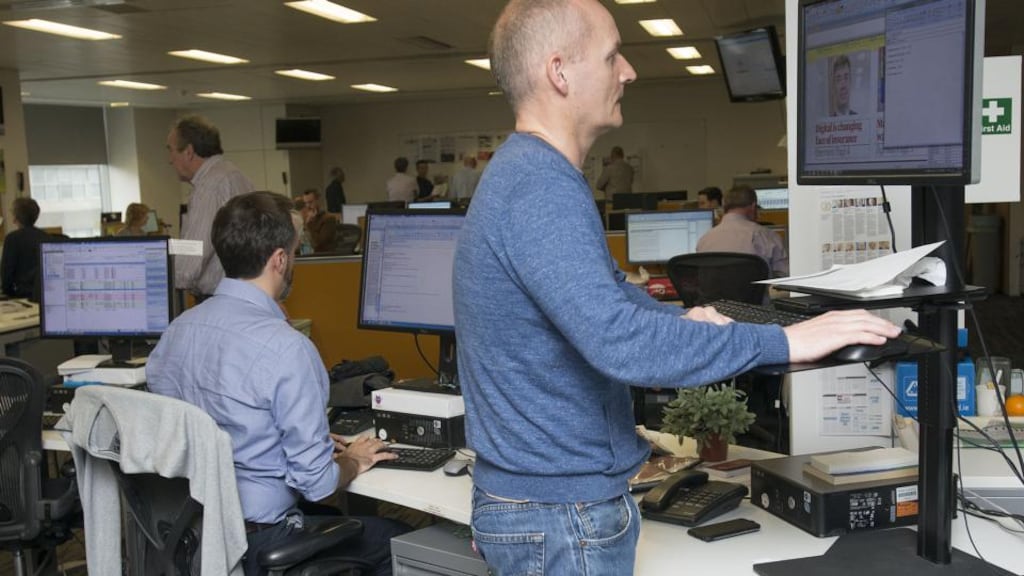It’s a question many office workers ask themselves: could sitting in front of a monitor all day be the cause of lower back pain? If it is, there could be a solution at hand.
After 20-odd years of sitting at work, my lower back pain had got steadily worse, while at the same time I gradually became more bloated from a gassy stomach that would balloon in size by mid-afternoon and bubble away like a cauldron of discontent until bedtime.
My attempts at back-pain relief focused on swimming (I swim a mile five times a week), Pilates spine-stretching exercises for 30 minutes every morning, walking for 30 minutes during my lunch hour and standing on the train to-and-from work. All of these feel great at the time but, after a while sitting in front of a monitor, the pain would return and lower back muscles stiffen.
I have consulted a chiropractor on the issue and sought massage treatment but the pain would always return after temporary respite. Eventually, my GP sent me for a lower-back MRI scan but this, too, could not pin down the pain-producing culprit.
To investigate my stomach complaints, I was sent for a colonoscopy and gastropscopy: these came back clean as a whistle – and then I was off to a dietician to determine if my eating habits were the source of my greenhouse gas emissions. The dietician suggested a strict foodmap diet where gas-friendly foods, like apples, nuts, honey and garlic, were replaced with the likes of fish and white meat. This approach produced a minor reduction in emissions after six months but nothing like a hoped-for clean air breakthrough.
With desperation setting in, I approached my employer who quickly organised an ergonomic assessment but, apart from my screen being slightly too high (causing some rocking of the neck), this hour-long consultation came up a blank.
A few weeks later, while on assignment at Facebook in Dublin, I noticed some of its staff alternating between standing and sitting at their desks. These stand-up sit-down desks, which move up and down at the touch of a button, seemed like a no-brainer solution to my issues.
Initially, I would alternate an hour's sitting with 30 minutes standing so my legs and feet would get used to the new routine
My employer, again, was quick to act after I requested such a desk and, within a few weeks of using one, I noticed steady improvement in my back pain and a sustained slide in greenhouse gas emissions. Being the first to get one on my floor, the desk generated quite an amount of comment, questions from passers-by and even a visit from the MD.
Initially, I would alternate an hour’s sitting with 30 minutes of standing so that my legs and feet would get used to the new routine. Since then, my standing time has gradually increased to around five hours with three sitting.
As a result, my lower back pain appears to be a thing of the past and I no longer consider myself a major contributor to global warming. During a recent restructuring at work, however, I was moved to a hot-desking team with little access to a stand-up desk. Within two weeks of consistently sitting down, all my problems returned no matter how much back stretching I did outside of office hours to counter the pain and stiffness.
Thankfully, my employer has since been able to provide access to a stand-up desk and my issues are on the mend. Sustained sitting, even on the best of office seats, while taking hourly breaks, obviously doesn’t work for me any more and I’m amazed at the number of colleagues who complain of back pain and want to try the standing option.
Opinion on stand-up desks is divided. Some point to them as a way to combat sedentary lifestyles – given that you’re burning around 20 per cent more calories by standing than sitting – and this reduces the risk of obesity, Type 2 diabetes, metabolic problems, cardiovascular disease, and cancer while improving mood, energy levels and alleviating back pain. Others say they lead to swollen feet, ankle and knee pain, muscular problems, and varicose veins.
James Levine, endocrinologist at the Mayo Clinic, is a leading expert in the field and his research has linked the cumulative impact of sustained sitting to obesity, diabetes and cancer. He was quoted in a recent Smithsonianmag.com article: “The way we live now is to sit all day, occasionally punctuated by a walk from the parking lot to the office. The default has become to sit. We need the default to be standing.”
Evidence also suggests that the negative effects of sustained sitting can’t be alleviated by short spurts of strenuous exercise after the average office worker has spent more than five-and-a-half hours sitting down during their typical day. Introducing standing and pacing into your day is a good way to counter sitting’s side effects. Some office workers in the US now walk on threadmills in front of their screens for relief. Others sit on bouncy exercise balls to correct their posture and develop their core muscles.
Treadmills and bouncy balls may sound extreme, or even seem faddish, but I’m just glad to have taken a stand against sustained sitting.








